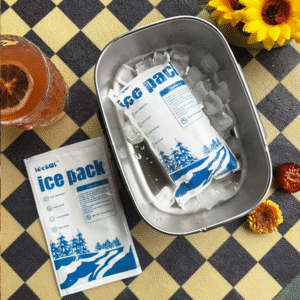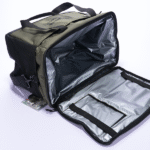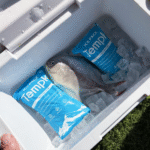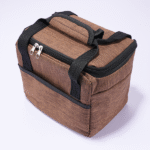Shipping perishable goods or temperature-sensitive items requires precise temperature control. Cooler dry ice packs provide a superior solution for maintaining cold temperatures throughout the shipping process. They are essential in industries like food, productos farmaceuticos, y biotecnología, where maintaining a specific temperature range is critical to product quality. This guide will explain how cooler dry ice packs work, sus ventajas, and how they can enhance your cold chain logistics in 2025.
-
What are cooler dry ice packs and how do they work?
-
How do cooler dry ice packs compare to traditional ice?
-
What are the benefits of using dry ice for shipping temperature-sensitive goods?
-
How can you safely handle and store dry ice?
-
What are the latest trends in cooler dry ice pack technology for 2025?
What Are Cooler Dry Ice Packs and How Do They Work?
Cooler dry ice packs are made from solid carbon dioxide (Co₂), que se sublima a -78,5°C (-109.3°F). This means that dry ice turns directly from a solid into a gas, No dejando residuos líquidos atrás. This is a major advantage over traditional ice, que se derrite en el agua, potentially damaging sensitive products. Dry ice packs are commonly used in insulated containers or cooler bags to maintain low temperatures during transit.
How Do Cooler Dry Ice Packs Work?
These packs work by being placed inside an insulated cooler or shipping container. Mientras el hielo seco se sublima, absorbe calor del entorno, thereby cooling the contents within the container. This cooling effect lasts for an extended period, keeping temperature-sensitive items like seafood, productos farmaceuticos, and biotech samples at optimal conditions.
Benefits of Using Cooler Dry Ice Packs
Cooler dry ice packs provide several advantages over traditional ice packs, making them the preferred choice for shipping temperature-sensitive goods.
| Beneficio | Descripción | Implicación práctica |
|---|---|---|
| Enfriamiento eficiente | Maintains extremely low temperatures for extended periods | Ideal for long-haul shipments, ensuring products stay cold longer |
| Sin residuo | Sublimada en gas, leaving no liquid | Previene daños por agua a los productos., especially in pharmaceutical shipments |
| Ligero | Lighter than traditional ice packs | Reduces shipping weight, lowering transportation costs |
Why Choose Cooler Dry Ice Packs?
-
Duración de enfriamiento más larga: Dry ice can maintain ultra-low temperatures for much longer than traditional ice. This makes it perfect for time-sensitive shipments, especialmente en largas distancias.
-
Sin daños por agua: A diferencia del hielo tradicional, El hielo seco no se derrite en el agua. This eliminates the risk of water damage to your products, which is particularly critical for shipping delicate pharmaceuticals or electronic items.
-
Energy and Cost Efficiency: Dry ice packs are more energy-efficient than other cooling methods, reducing the overall weight of the shipment while ensuring that goods remain at the correct temperature.
How Do Cooler Dry Ice Packs Compare to Traditional Ice?
Cooler dry ice packs offer several advantages over traditional ice. Below is a comparison of both methods:
| Característica | Hielo seco | Hielo tradicional |
|---|---|---|
| Duración del enfriamiento | Arriba a 48 horas | 6-8 horas |
| Peso | Lighter and more efficient | mas pesado, adds to shipping weight |
| Residuo | Sublimada en gas, sin liquido | Se derrite en el agua, productos potencialmente dañinos |
As seen from the comparison, dry ice outperforms traditional ice in both cooling duration and weight efficiency, making it the better choice for long-distance and sensitive shipments.
Best Practices for Using Cooler Dry Ice Packs
Para una máxima eficacia, it’s essential to follow best practices when using cooler dry ice packs:
-
Ventilación adecuada: Ensure that the shipping container is well-ventilated to allow the carbon dioxide gas to escape safely. Sin una ventilación adecuada, the buildup of CO₂ can be hazardous.
-
Utilice la cantidad adecuada de hielo seco: Por cada 24 libras de productos perecederos, usar 1-2 lbs of dry ice to maintain cooling over 24-48 horas. This ensures that the products stay at the desired temperature without wasting dry ice.
-
Use contenedores aislados: To maximize cooling efficiency and reduce the rate of sublimation, always use insulated coolers or boxes. These containers minimize the exposure of dry ice to the outside environment, helping it last longer.
Ejemplo del mundo real:
A biotech company improved its temperature control by switching to cooler dry ice packs for transporting vaccines. El resultado fue un 40% improvement in temperature retention compared to their previous cooling methods, which significantly reduced the risk of spoilage.
How to Safely Handle and Store Dry Ice During Shipping
Handling dry ice requires special precautions due to its extremely cold temperature and the carbon dioxide gas it releases. Here are safety tips for handling dry ice:
-
Usar equipo de protección: Siempre maneje el hielo seco con guantes aislados para evitar la congelación.
-
Almacenamiento adecuado: Guarde el hielo seco en áreas bien ventiladas., away from heat sources to avoid rapid sublimation. Use insulated containers to maintain its effectiveness.
-
Asegurar la ventilación: Make sure that shipping containers have adequate ventilation to allow the gas to escape safely.
2025 Trends in Cooler Dry Ice Pack Technology
The cooler dry ice pack industry is rapidly evolving, driven by technological advancements and an increasing emphasis on sustainability. Some key trends to watch for in 2025 incluir:
-
Producción sostenible: More companies are exploring eco-friendly dry ice production methods, aiming to reduce carbon footprints and lower the environmental impact of their cold-chain logistics.
-
Embalaje inteligente: IoT-enabled sensors are being integrated into cooler dry ice packs, allowing real-time temperature monitoring during transit. This innovation improves shipping reliability and ensures products remain within the required temperature range.
-
Regulatory Advancements: As global regulations on shipping temperature-sensitive goods become stricter, companies are adapting by investing in compliance solutions to ensure their shipments meet international standards.
Preguntas frecuentes
Q1: ¿Cuánto hielo seco necesito para el envío??
Típicamente, 1-2 libras de hielo seco por 24 lbs of product is recommended for a 24-48 envío por horas. The exact amount will depend on the type of goods and external temperatures.
Q2: Can dry ice be used to ship liquids?
Sí, dry ice is effective for shipping liquids, provided the container is properly sealed and ventilated. It helps maintain the required low temperature for liquids without freezing them solid.
Q3: ¿Existen regulaciones para el envío de hielo seco a nivel internacional??
Sí, international shipments containing dry ice must comply with IATA and DOT regulations. Ensure that your logistics provider is familiar with the specific requirements for shipping dry ice across borders.
Conclusión y próximos pasos
Cooler dry ice packs are a reliable solution for shipping temperature-sensitive goods. They offer long-lasting cooling power, reduce the risk of water damage, and improve overall shipping efficiency. By understanding how to use dry ice effectively, you can ensure that your cold chain logistics are optimized for success.
Que hacer a continuación:
-
Switch to dry ice for your next shipment to improve temperature control and reduce spoilage.
-
Consult with a logistics expert to ensure you’re using the best methods for shipping with dry ice.
-
Explore smart packaging options to enhance your cold-chain logistics and meet the latest regulatory standards.
Acerca de Tempk
Y tempk, we specialize in providing dry ice solutions that ensure the safe transportation of your temperature-sensitive goods. With our advanced technology and commitment to customer satisfaction, we help businesses keep their products cool and fresh during transit.
Llamado a la acción: Listo para optimizar la logística de su cadena de frío? Contact us today for expert advice and high-quality cooler dry ice packs.
























